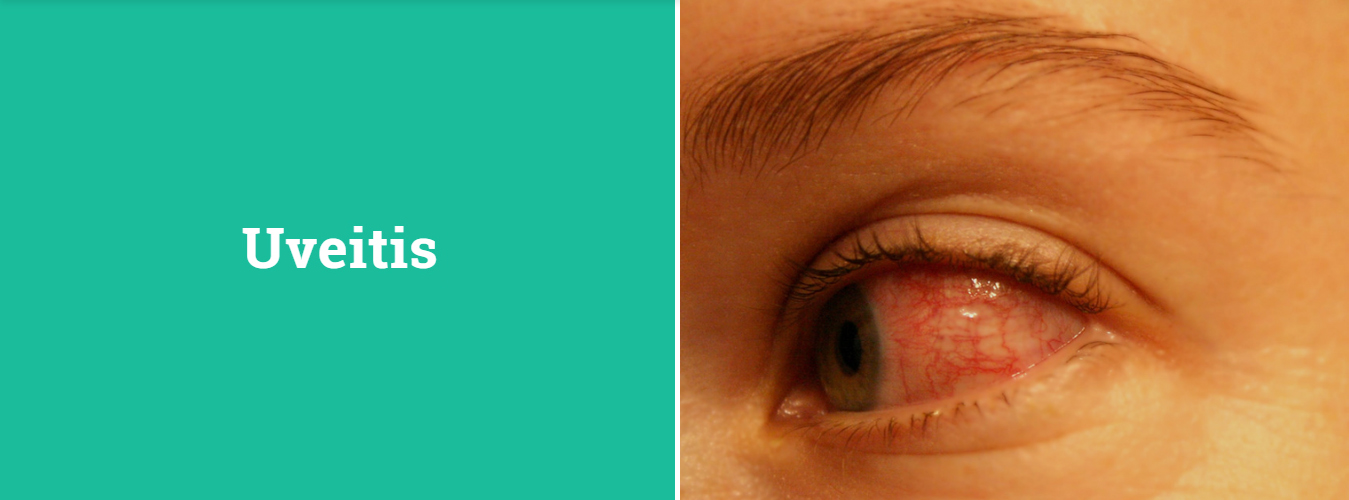Uveitis Services
Uveitis or ocular inflammation is a condition where the middle layer of the eye gets inflamed.
This section will explain more about Uveitis and answer some questions that you may have. It will also advise you on how best you can manage Uveitis.
What is Uveitis?
Uveitis is an inflammation that occurs in the middle layer of the eye. It can also lead to inflammation in the adjacent areas, like the retina and fluid in the back of the eye (called vitreous).
To understand what Uveitis is, we must first know how a normal eye works. The eye is like a camera. The lens allows light to pass through it and then focuses that light on a film at the back of the camera to form a clear picture.
In a normal eye the lens is clear and allows the light to pass through it. The light is focused on a thin film called the retina, which is located at the back of the eye. The different regions of the eye assimilate this light and send a message to the brain, thus forming the image that we see.
What Causes Uveitis?
While the basic cause for Uveitis remains undetermined in most cases, it may be a manifestation of systemic diseases. It can also occur as a result of an auto-immune reaction to ocular antigens or be due to a local infection caused by virus, bacteria, fungus or a parasite.
Doctors often call for laboratory tests, X-rays and consultations with specialists to determine the cause of Uveitis. However, even after detailed tests they may still not understand its cause.
Types of Uveitis
Uveitis can be of four types, depending upon the location of the inflammation.
Anterior Uveitis: This kind of Uveitis affects the front or anterior portion of the eye. The common symptoms are redness, watering, decreased vision, pain in the eye and photophobia or intense discomfort while looking at light. In low-grade inflammation, the eye may appear normal but still have signs of damage.
Intermediate Uveitis: In this type of Uveitis, the uveal tract (middle part of the middle layer) is affected. The patient usually sees black spots in front of the eye. There may be loss of vision due to fluid accumulation in the central area of the retina.
Posterior Uveitis: This type affects the back or the posterior portion of the eye. The eye may appear normal or there may be little inflammation in the front. The inflammation may affect the retina, choroid (posterior or back part of the middle layer) or both. The inflammation may be localized at several places, or even widely spread. Patients usually complain of poor vision, or the absence of central or peripheral vision.
Panuveitis: Panuveitis affects the entire uveal tract (middle layer from the front and back). It often causes a distinct blurring of the vision with varying degrees of pain and redness. This is also associated with inflammation in the vitreous cavity at the back of the eye.
Treatment Strategies
Even though there may not be a permanent cure for Uveitis, each attack can be treated, depending upon the cause, severity and location of the inflammation. The treatment may include eye drops, injections under the eye or oral medication.
The most commonly prescribed eye drops relieve the muscles inside the eye and help to dilate the pupil, temporarily paralyzing the sphincter muscles, to relieve the pain. This may cause some difficulty in near vision and increase the feeling of glare in bright light. Patients are advised to use dark glasses while going out in the day.
To control inflammation, steroids may be given in the form of drops, injections around the eye or tablets. At such times, a depot steroid injection is used, which causes a slow release of the drug into the eye. The drug usually lasts for several weeks.
When the inflammation is extensive or severe, oral drugs such as steroids and immunosuppressive drugs are needed. These drugs have potential side effects, but they are often not serious and their effects are reversible, once treatment is discontinued.
Important Advice about Medication
- Please take the medicines as advised by the doctor; do not start or stop the medication on your own. If you are on oral steroid therapy and have to undergo any surgery, please inform your doctor. If you have taken oral steroids for more than two weeks, do not stop suddenly, as this could have serious problems.
- Keep your medication where you can see it easily.
- Schedule your medication intake around your daily routine, like when you wake up in the morning, at meal times or at bedtime.
- If you forget to use your eye drops, use them as soon as you remember, instead of waiting till the next scheduled time. Then get back on schedule for the next dose.
- Watch out for side effects like changes in vision. Inform your doctor immediately about them or on your next appointment. Schedule your check-ups regularly.
- When consulting doctors for other problems, tell them about the medicines that you are using. Eye medications can affect other parts of the body too.
Potential Side-effects
Oral steroids may cause acidity, mild stomach pain, increase in weight, acne or pimples. In rare cases, they can induce diabetes, hypertension, osteoporosis (weakening of the bones), nervousness and depression. Women are advised to avoid pregnancy (contraceptive devices can be used) while on treatment with oral steroids or immunosuppressive drugs.
Some immunosuppressive drugs interfere with the basic metabolic process of the body; many of them cause bone marrow depression, thereby reducing the blood count. Patients are advised periodic blood tests while taking the treatment, to monitor the side effects of the drugs.
Can Uveitis recur?
Yes, in many cases Uveitis can recur. The frequency and severity of the attacks is however, unpredictable. Consult your ophthalmologist as soon as you notice any signs of recurrence; this will make the treatment simpler and lead to a quicker resolution of Uveitis.
What are the likely complications?
Patients with Uveitis can develop complications like cataract, glaucoma, i.e., raised intraocular pressure (pressure of the eye, similar to blood pressure) and macular edema (fluid accumulation in the central part of the retina). This can lead to reduced vision. Such complications can be managed medically or surgically once the inflammation is controlled.
Can Uveitis lead to loss of vision?
Uveitis can lead to loss of vision if not managed properly. However, with modern diagnostic methods, better medication and surgical techniques, the prognosis for most patients is very good. It is critical that the disease is identified early and treated properly. It is also important for Uveitis patients to get their eyes checked periodically, even if there are no symptoms.
What you should know
You must realize that every case of Uveitis is different - your case may not be exactly like any of the types described here. Do not hesitate to ask your doctor for further information.
Other online resources, such as a Uveitis support group can be accessed at, www.uveitis.org
Sustained Drug Delivery for Posterior Uveitis
The main line of treatment for non-infectious posterior uveitis involves systemic or periocular steroids. They offer excellent inflammation control but could lead to side effects such as diabetes mellitus, hypertension, weakening of bones, myopathy, mood changes and weight gain. Therefore, steroid sparing agents (or immunomodulatory agents) are prescribed to reduce the total dose and administration period of systemic steroids.
LVPEI is a part of the trial process for a new drug delivery system wherein a tiny device with a minuscule amount of steroid is surgically inserted into the vitreous cavity of the eye.



